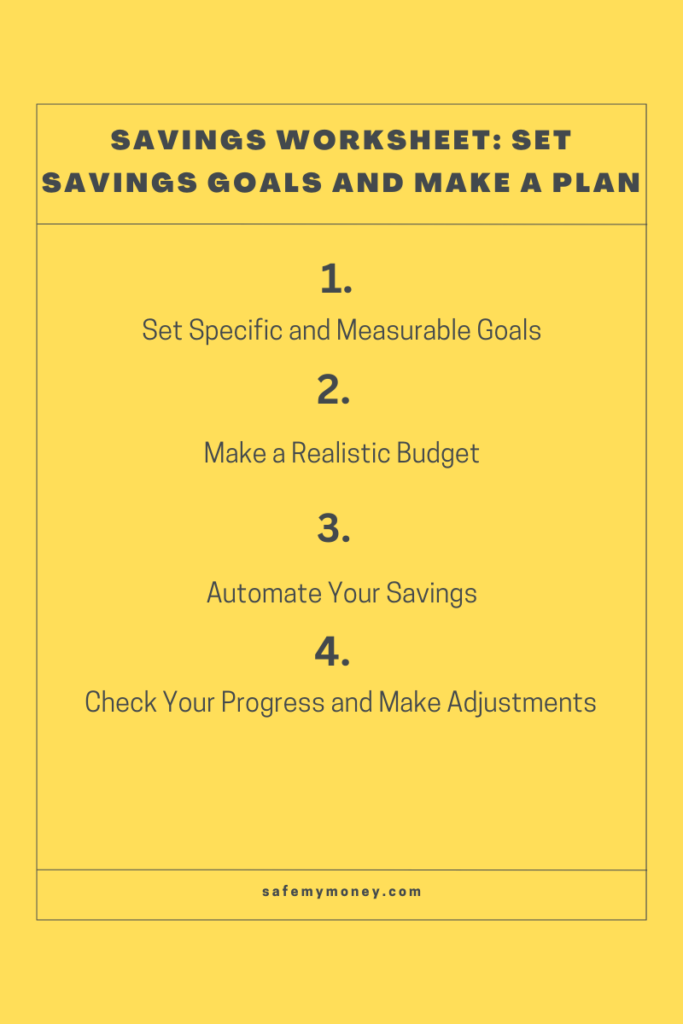You want to get your finances in order and save some cash, right? Everyone knows saving money is important, but figuring out how to actually do it is tough. Where do you even start? Don’t worry, we’ve got you covered. We put together the ultimate bundle of money management worksheets to help you save more and spend less. These worksheets will walk you through creating a realistic budget, tracking your spending, paying off debt, and setting financial goals. You’ll learn simple money-saving tips and strategies to find extra cash each month. Get ready to gain control of your money once and for all. The best part is you can do it all on your own time and at your own pace using these helpful worksheets. Saving money doesn’t have to be hard, you just need the right tools and motivation. This bundle provides both so you can start building wealth and achieve financial freedom. What are you waiting for? Dive in and take the first step towards a richer financial future.
Create a Budget Worksheet: The Foundation of Money Management
A budget worksheet is the foundation for gaining control of your money. Creating a budget allows you to see exactly how much money is coming in and going out each month. You’ll be able to allocate your funds to essential expenses first, then discretionary items.
Top 6 Unknown Facts You Need to Know About Budget Management
To get started, list all your income sources and the amount from each. Then, list your fixed expenses – things like rent, utilities, and loan payments. Next, your variable expenses – groceries, gas, entertainment. Estimate costs for each.
Once you have your expenses listed, compare them to your income. Make sure you’re not spending more than you earn! Look for expenses you can reduce or eliminate. Even saving $10 here and there can make a big difference.
Review your budget often and make changes as needed. Some months you may spend more on holidays or vacations. In other months you may spend less. A budget gives you flexibility while keeping you on track to achieve your financial goals.
Creating good financial habits now will benefit you for life. A budget worksheet is an easy tool to help you spend smart and save more so you can achieve important life goals. Give it a try – you’ll gain valuable insights into your money flow and find new ways to improve your financial well-being. Take control of your money today with a comprehensive budget worksheet. Your financial future self will thank you!
Expenses Worksheet: Track Your Monthly Spending
Once you’ve tracked your income, it’s time to get real about your spending. This expenses worksheet will open your eyes to where your money is really going each month.
Grab your bank and credit card statements for the last 3-6 months. List each expense, big or small, in its own row along with the amount. Don’t leave anything out, from rent to your daily coffee. Total each month’s expenses at the bottom.
- See any surprises? Maybe you’re spending more on dining out or entertainment than you realized. Look for expenses you can reduce or eliminate. Even saving $10-$20 here and there can add up to hundreds per year.
- Are there seasonal or annual expenses you need to budget for like holidays, birthdays or insurance premiums? Make a plan to set aside money each month so you’re not caught short.
- How do your total monthly expenses compare to your income? If you’re in the red, it’s time for a budget makeover. Look for ways to boost your income or cut excess spending.
Tracking your spending is the key to gaining control of your finances. Use these worksheets each month to build awareness and make progress toward your money goals. Small changes can have a big impact, so keep at it and don’t get discouraged. With regular monitoring, you’ll be on your way to spending less and saving more in no time!
Savings Worksheet: Set Savings Goals and Make a Plan

Set Specific and Measurable Goals
The first step is to determine how much you want to save each month or year. Be specific by setting a concrete dollar amount, like $200 per month or $2,400 per year. Also, make your goals measurable so you can track your progress. For example, aim to save 10% of your take-home pay each month. Start with whatever amount you can, then increase it as your income rises.
- Short-term goals: Save for a down payment on a car or home, pay off high-interest debt, and fund a vacation.
- Long-term goals: Save for retirement, college education, and healthcare expenses.
60 Best Money-Saving Challenges That You Should Try From Today
Make a Realistic Budget
Examine your income and expenses to find areas where you can cut costs. Look for ways to trim your budget by $20-$50 per month to put toward your savings. Maybe you can eat out one less time per week or reduce your utility bills by adjusting the thermostat. A realistic budget that cuts out excess spending is key to achieving your savings goals.
Automate Your Savings
The easiest way to save money is to automate transfers to your savings account each month. Most banks allow you to set up automatic transfers from your checking to your savings account. Start with the amount you want to save each month, like $50 or $100, and have that amount transferred to your savings account each month. This “set it and forget it” approach means you save money regularly without having to think about it.
Check Your Progress and Make Adjustments
At least once a quarter, check in on your savings goals and make sure you’re on track. If you’re falling behind, look for additional ways to cut costs or increase your income. You may need to rebalance your budget or increase the amount you’re automatically saving each month. Staying accountable to yourself and making adjustments as needed will help ensure you achieve your savings goals over the long run.
Debt Payoff Worksheet: Create a Customized Debt Elimination Plan
Paying off your debt is challenging, but having a solid plan in place can help motivate you and keep you on track. This worksheet helps you create a customized debt payoff strategy based on your unique situation.
List Your Debts
First, gather statements for all your credit cards, personal loans, auto loans, student loans, and any other debts you owe. List each debt, the interest rate, minimum payment, and balance owed. See all your debts in one place so you know exactly what you’re up against.
Rank Your Debts
Next, rank your debts from highest to lowest interest rate. Paying off high-interest debts first saves you money in the long run. If there are any debts with rates over 10-15%, make those a priority.
Set a Payoff Goal
Decide if you want to use the “debt snowball” or “debt avalanche” method. The snowball method focuses on paying off small debts first for quick wins, while the avalanche tackles high-interest debts first. Choose a method and set a target payoff date for each debt.
Cut Expenses and Increase Income
To achieve your goals, look for ways to cut back on discretionary spending and make more money. Reduce or cut out things like dining out, entertainment, and hobbies. Ask for a raise at your job or develop a side gig to generate extra income to put towards your debt. Every little bit helps.
Make a Payment Plan
With your debts prioritized and goals set, determine how much you can put toward your debt payments each month. Then, allocate that amount to your minimum payments and any extra to your highest-priority debts. As you pay off each debt, take that payment and apply it to the next debt on your list. Stick to the plan and stay motivated – you’ve got this! With time and consistency, you will achieve debt freedom.
Net Worth Worksheet: Calculate Your Financial Progress
To track your financial progress, calculating your net worth is key. Your net worth is the total value of all your assets minus your liabilities. Assets are things you own that have value like cash, investments, and property. Liabilities are what you owe like mortgage, credit card debt, and loans.
Why Calculate Your Net Worth?
Calculating your net worth gives you an overview of where you stand financially. It helps you see if you’re gaining or losing ground over time based on life changes and financial decisions. If your net worth is increasing over time, you’re making progress! If it’s decreasing, it may be time for a financial check-in.
How to Calculate Your Net Worth
- List all your assets and their current market values. This includes things like:
- Cash in bank accounts
- Investment accounts (401(k), IRA, brokerage)
- Real estate
- Valuable collections or assets
- List all your liabilities like:
- Mortgage balance
- Credit card balances
- Auto loans
- Student loans
- Subtract your total liabilities from your total assets. The result is your net worth.
- Track your net worth over time to see progress. Aim for steady growth by spending less, earning more, paying off debt, and investing when possible.
Calculating your net worth may seem tedious, but it provides an honest look at where you stand financially. Make it a habit to calculate your net worth annually or quarterly so you can make adjustments as needed to keep progressing towards your goals. Staying on top of your net worth and making continual improvements is key to building wealth and achieving financial freedom.
FAQs
Do I have to use all the worksheets?
No, the worksheets are designed to be used individually or in any combination that works for you. Start with the areas you want to focus on first, like budgeting or debt payoff, and add in other worksheets over time as needed.
How often should I update the worksheets?
It depends on which worksheets you’re using, but a good rule of thumb is:
- Update your budget, expense tracker, and net worth worksheets monthly.
- Review your financial goals and debt payoff worksheets quarterly.
- Revisit your spending plan and look for ways to cut costs or earn additional income twice a year.
Can I share the worksheets with my spouse or partner?
Of course! In fact, using the worksheets together is a great way to get on the same page financially, set shared goals and hold each other accountable. You should each fill out any worksheets individually first to identify your personal priorities and perspectives. Then, compare answers and look for common ground and compromises.
Do you provide guidance on how to improve my finances?
The worksheets themselves provide a framework for gaining control of your money and working towards important financial milestones. However, improving your finances often requires making changes to your daily habits and mindset. I offer general tips and strategies to help you:
- Spend less than you earn. Pay off high-interest debts. Automate as much as possible.
- Look for expenses you can reduce or eliminate. Ask yourself if each purchase is a “want” or a “need”.
- Find ways to earn additional income on the side like a part-time job, freelancing, selling unwanted items, etc.
- Check your accounts regularly and monitor for any unauthorized charges or fees.
The ultimate key to money management success is making continuous progress, however small. Stick with it and stay committed to your goals. You’ve got this!
Save More, Spend Less – It’s That Simple
To improve your financial situation, the formula is straightforward: increase your income and decrease your spending. Easier said than done, right? With the help of the worksheets in this bundle, you’ll be well on your way to saving more and spending less in no time.
Through budgeting, you’ll gain awareness of your cash flow and spending habits. Look for expenses you can reduce or eliminate, like eating out or entertainment. Even small changes can make a big difference. Are there ways to earn additional income on the side, such as a part-time job or freelancing? Every extra dollar you bring in is a dollar more to put toward your financial goals.
Make a Plan and Take Action
It’s not enough to have good intentions – you need concrete goals and a realistic plan to achieve them. Decide how much you want to save each month and set up automatic transfers to move money from your checking to your savings account. Start paying off debt by making payments that exceed the minimum. Review your progress regularly and make adjustments as needed to stay on track.
Building better financial habits and making fiscally responsible choices requires work and dedication. But with the right mindset and tools to support you, saving more and spending less can become second nature. The worksheets in this bundle provide a framework to help make that possible. Use them to gain insight into your finances, set goals, make a plan, track your progress, and achieve greater financial freedom and security. Together, saving more and spending less, one day at a time.
Conclusion
That’s it – a powerful set of tools to transform your financial life. With these comprehensive worksheets, you’ve got everything you need to gain control of your money once and for all. No more flying blind or hoping for the best each month. Now you can plan, track, analyze, and make smart money decisions to achieve your big goals. The hard work is done for you – just print, grab a pen, and get started. Before you know it, you’ll be saving more, spending smarter, and watching your net worth climb. Take it from me, putting in the effort to manage your money with intention will be one of the most rewarding things you do. Your future self will thank you. So what are you waiting for? It’s time to get your financial house in order and start reaping the benefits. You’ve got this!


